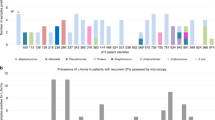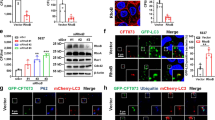Abstract
The superficial bladder epithelium is a powerful barrier to urine and also serves as a regulator of bladder volume, which is achieved by apical exocytosis of specialized fusiform vesicles during distension of the bladder. We report that type 1 fimbriated uropathogenic Escherichia coli (UPEC) circumvents the bladder barrier by harboring in these Rab27b/CD63-positive and cAMP-regulatable fusiform vesicles within bladder epithelial cells (BECs). Incorporation of UPEC into BEC fusiform compartments enabled bacteria to escape elimination during voiding and to re-emerge in the urine as the bladder distended. Notably, treatment of UPEC-infected mice with a drug that increases intracellular cAMP and induces exocytosis of fusiform vesicles reduced the number of intracellular E. coli.
This is a preview of subscription content, access via your institution
Access options
Subscribe to this journal
Receive 12 print issues and online access
$209.00 per year
only $17.42 per issue
Buy this article
- Purchase on Springer Link
- Instant access to full article PDF
Prices may be subject to local taxes which are calculated during checkout




Similar content being viewed by others
References
Hooton, T.M. & Stamm, W.E. Diagnosis and treatment of uncomplicated urinary tract infection. Infect. Dis. Clin. North Am. 11, 551–581 (1997).
Svanborg, C. & Godaly, G. Bacterial virulence in urinary tract infection. Infect. Dis. Clin. North Am. 11, 513–529 (1997).
Martinez, J.J., Mulvey, M.A., Schilling, J.D., Pinkner, J.S. & Hultgren, S.J. Type 1 pilus-mediated bacterial invasion of bladder epithelial cells. EMBO J. 19, 2803–2812 (2000).
Duncan, M.J., Li, G., Shin, J.S., Carson, J.L. & Abraham, S.N. Bacterial penetration of bladder epithelium through lipid rafts. J. Biol. Chem. 279, 18944–18951 (2004).
Min, G. et al. Localization of uroplakin Ia, the urothelial receptor for bacterial adhesin FimH, on the six inner domains of the 16 nm urothelial plaque particle. J. Mol. Biol. 317, 697–706 (2002).
Lewis, S.A. Everything you wanted to know about the bladder epithelium but were afraid to ask. Am. J. Physiol. Renal Physiol. 278, F867–F874 (2000).
Hu, P. et al. Role of membrane proteins in permeability barrier function: uroplakin ablation elevates urothelial permeability. Am. J. Physiol. Renal Physiol. 283, F1200–F1207 (2002).
Apodaca, G. Stretch-regulated exocytosis of discoidal vesicles in urinary bladder epithelium. Urology 57, 103–104 (2001).
Apodaca, G. The uroepithelium: not just a passive barrier. Traffic 5, 117–128 (2004).
Chen, Y. et al. Rab27b is associated with fusiform vesicles and may be involved in targeting uroplakins to urothelial apical membranes. Proc. Natl. Acad. Sci. USA 100, 14012–14017 (2003).
Orndorff, P.E. & Falkow, S. Organization and expression of genes responsible for type 1 piliation in Escherichia coli. J. Bacteriol. 159, 736–744 (1984).
Wang, E., Truschel, S. & Apodaca, G. Analysis of hydrostatic pressure-induced changes in umbrella cell surface area. Methods 30, 207–217 (2003).
Burgoyne, R.D. & Morgan, A. Secretory granule exocytosis. Physiol. Rev. 83, 581–632 (2003).
Truschel, S.T. et al. Stretch-regulated exocytosis/endocytosis in bladder umbrella cells. Mol. Biol. Cell 13, 830–846 (2002).
Schilling, J.D., Mulvey, M.A., Vincent, C.D., Lorenz, R.G. & Hultgren, S.J. Bacterial invasion augments epithelial cytokine responses to Escherichia coli through a lipopolysaccharide-dependent mechanism. J. Immunol. 166, 1148–1155 (2001).
Carbone, M. et al. Cytokine induction in murine bladder tissue by type 1 fimbriated Escherichia coli. Ann. NY Acad. Sci. 963, 332–335 (2002).
Uehling, D.T., Johnson, D.B. & Hopkins, W.J. The urinary tract response to entry of pathogens. World J. Urol. 17, 351–358 (1999).
Mulvey, M.A. et al. Induction and evasion of host defenses by type 1-piliated uropathogenic Escherichia coli. Science 282, 1494–1497 (1998).
Vergara, J., Zambrano, F., Robertson, J.D. & Elrod, H. Isolation and characterization of luminal membranes from urinary bladder. J. Cell Biol. 61, 83–94 (1974).
Rodriguez, A., Martinez, I., Chung, A., Berlot, C.H. & Andrews, N.W. cAMP regulates Ca2+-dependent exocytosis of lysosomes and lysosome-mediated cell invasion by trypanosomes. J. Biol. Chem. 274, 16754–16759 (1999).
Tardieux, I. et al. Lysosome recruitment and fusion are early events required for trypanosome invasion of mammalian cells. Cell 71, 1117–1130 (1992).
Andrews, N.W. Living dangerously: how Trypanosoma cruzi uses lysosomes to get inside host cells, and then escapes into the cytoplasm. Biol. Res. 26, 65–67 (1993).
Anderson, J.D., Adams, M.A., Webster, H.M. & Smith, L. Growth properties of mecillinam-resistant bacterial variants in urine. Antimicrob. Agents Chemother. 12, 559–562 (1977).
Anderson, J.D., Eftekhar, F., Aird, M.Y. & Hammond, J. Role of bacterial growth rates in the epidemiology and pathogenesis of urinary infections in women. J. Clin. Microbiol. 10, 766–771 (1979).
Anderson, G.G. et al. Intracellular bacterial biofilm-like pods in urinary tract infections. Science 301, 105–107 (2003).
Eto, D.S., Sundsbak, J.L. & Mulvey, M.A. Actin-gated intracellular growth and resurgence of uropathogenic Escherichia coli. Cell. Microbiol. 8, 704–717 (2006).
Mulvey, M.A., Schilling, J.D. & Hultgren, S.J. Establishment of a persistent Escherichia coli reservoir during the acute phase of a bladder infection. Infect. Immun. 69, 4572–4579 (2001).
Seamon, K.B., Padgett, W. & Daly, J.W. Forskolin: unique diterpene activator of adenylate cyclase in membranes and in intact cells. Proc. Natl. Acad. Sci. USA 78, 3363–3367 (1981).
Seamon, K.B. & Daly, J.W. Forskolin: a unique diterpene activator of cyclic AMP-generating systems. J. Cyclic Nucleotide Res. 7, 201–224 (1981).
Drewes, S.E., George, J. & Khan, F. Recent findings on natural products with erectile-dysfunction activity. Phytochemistry 62, 1019–1025 (2003).
Wajima, Z. et al. Intravenous colforsin daropate, a water-soluble forskolin derivative, prevents thiamylal-fentanyl-induced bronchoconstriction in humans. Crit. Care Med. 30, 820–826 (2002).
Meyer, B.H., Stulting, A.A., Muller, F.O., Luus, H.G. & Badian, M. The effects of forskolin eye drops on intra-ocular pressure. S. Afr. Med. J. 71, 570–571 (1987).
Styczynski, J. & Wysocki, M. Ex vivo modulation of response to prednisolone in childhood acute lymphoblastic leukaemia. Br. J. Haematol. 133, 397–399 (2006).
Abraham, S.N. et al. Protection against Escherichia coli-induced urinary tract infections with hybridoma antibodies directed against type 1 fimbriae or complementary D-mannose receptors. Infect. Immun. 48, 625–628 (1985).
Acknowledgements
We thank A. Aballay (Department of Molecular Genetics and Microbiology, Duke University Medical Center) for the gift of the S. enterica SL1344 and M. Kuehn (Department of Biochemistry, Duke University Medical Center) for the pKEN-HcRed plasmid; W. Fennell and H. Estrada for their help with electron microscopy; A. Aballay, R. Valdivia and M. Kuehn for helpful discussion; C. Shelburne and C. Kunder for their critical reading of the manuscript. This work was supported by US National Institutes of Health grants R01 AI-35678, R37DK50814 and R21 AI056101.
Author information
Authors and Affiliations
Contributions
B.L.B. performed the experiments in this work. G.L. produced the GFP-Rab27b–expressing 5637 BECs and the Rab27b knockdown 5637 BECs. J.S. performed the IL-6 ELISA. M.J.D. initiated the laboratory use of the in vitro model of E. coli infection of 5637 BECs. B.L.B, D.Z and S.A. wrote the paper; the other authors read and commented on the manuscript.
Corresponding authors
Ethics declarations
Competing interests
The authors declare no competing financial interests.
Supplementary information
Supplementary Fig. 1
E. coli interact with secretory lysosomes of 5637 BECs in vitro. (PDF 387 kb)
Supplementary Fig. 2
E. coli enters BECs through CD63+ vesicles and bypasses the classical endocytic pathway. (PDF 1055 kb)
Supplementary Fig. 3
Loss of intracellular E. coli is not due to BEC lysis or bacterial degradation. (PDF 247 kb)
Rights and permissions
About this article
Cite this article
Bishop, B., Duncan, M., Song, J. et al. Cyclic AMP–regulated exocytosis of Escherichia coli from infected bladder epithelial cells. Nat Med 13, 625–630 (2007). https://doi.org/10.1038/nm1572
Received:
Accepted:
Published:
Issue Date:
DOI: https://doi.org/10.1038/nm1572
This article is cited by
-
Mechanisms of oxidative stress in interstitial cystitis/bladder pain syndrome
Nature Reviews Urology (2024)
-
Uropathogenic Escherichia coli endeavors: an insight into the characteristic features, resistance mechanism, and treatment choice
Archives of Microbiology (2023)
-
The urothelium: a multi-faceted barrier against a harsh environment
Mucosal Immunology (2022)
-
Immunomodulation therapy offers new molecular strategies to treat UTI
Nature Reviews Urology (2022)
-
The role of caspase-1, caspase-4 and NLRP3 in regulating the host cell response evoked by uropathogenic Escherichia coli
Scientific Reports (2022)



